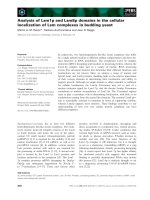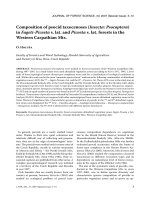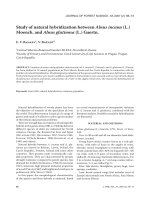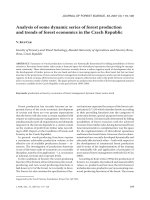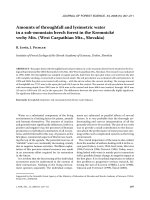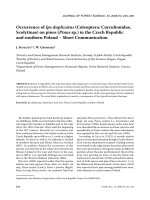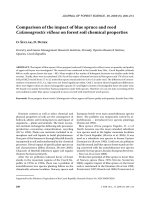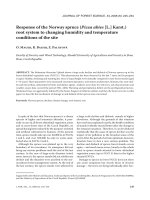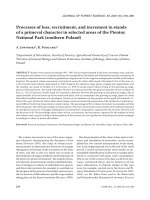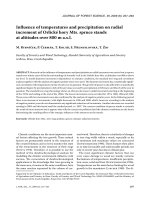Báo cáo lâm nghiệp: "Amounts of throughfall and lysimetric water in a sub-mountain beech forest in the Kremnické vrchy Mts" ppt
Bạn đang xem bản rút gọn của tài liệu. Xem và tải ngay bản đầy đủ của tài liệu tại đây (173.81 KB, 5 trang )
J. FOR. SCI., 54, 2008 (5): 207–211 207
JOURNAL OF FOREST SCIENCE, 54, 2008 (5): 207–211
Water as a substantial component of the living
environment is a limiting factor for plants, animals
and humans themselves. e amount of (surface
and ground) water significantly influences, both in a
positive and negative way, the processes of biomass
production in individual constituents of all ecosys-
tems, and the life itself in this way. At present, at the
first place, commercial aspects of this fact are reach-
ing the top of the agenda. e potential reserves of
“suitable” water are continually decreasing, mainly
due to negative human activities. riftless exploi-
tation of this precious natural resource can result
in an enormous effort required for its restoration
in the future.
It is evident that the functioning of the individual
ecosystems must be understood in the context of
their interactions. Nothing in the living environ-
ment operates separately. e individual compo-
nents are subjected to parallel effects of several
factors. It is very probable that the thorough un-
derstanding and correct interpretation of all the
grounds will never be reached. e aim of our work
was to provide a small contribution to the discus-
sion about the performance of some processes run-
ning within such complicated systems as the living
environment.
e crucial importance of the issue is also evident
from the number of authors dealing with it in the re-
cent past (F, L 1994; M, M
1994; P 1996; D 1996). Today, every-
thing linked with water is mainly put in connection
with a possible climate change, its negative impact at
the first place. It is of cardinal importance to subject
this problem to progressive serious research, fol-
lowing the suit of K (1984b), L (1988),
G and T (1999), Š (2003).
Supported by the Scientific Grant Agency of the Ministry of Education of Slovakia and Slovak Academy of Sciences VEGA,
Project No. 2/0045/08.
Amounts of throughfall and lysimetric water
in a sub-mountain beech forest in the Kremnické
vrchy Mts. (West Carpathian Mts., Slovakia)
R. J, J. P
Institute of Forest Ecology of the Slovak Academy of Sciences, Zvolen, Slovakia
ABSTRACT: e paper deals with throughfall and soil percolation in a sub-mountain beech forest situated at the Eco-
logical Experimental Site (EES) Kremnické vrchy Mts. (the West Carpathian Mts., Slovakia). e research was conducted
in 1988–2008. e throughfall was sampled at regular periods, both from the open plot (clear-cut) and from the plot
with complete stocking, covered with a mature beech stand. e soil percolation was evaluated with soil lysimeters. In
1989 and 2004, the plots were treated with cutting – with the aim to reduce the current stocking. e average amount
of throughfall was 772.2 mm in the open plot and 616.3 mm in the control. e amount of soil percolation decreased
with increasing depth: from 398.9 mm to 103.8 mm in the control and from 488.8 mm (surface) through 169.9 mm
(10 cm) to 188.8 mm (25 cm) in the open plot. e differences between the plots were statistically highly significant.
No significant differences were found between the soil horizons.
Keywords: throughfall; lysimeter; sub-mountain beech forest; water balance
208 J. FOR. SCI., 54, 2008 (5): 207–211
MATERIAL AND METHODS
We monitored throughfall and soil solutions
(K 2002) in beech stands at the Ecological
Experimental Site Kremnické vrchy Mts., using the
methods elaborated by D (1996). In general,
we measured the throughfall amounts after each
precipitation event. e water was collected into
vessels with precisely specified interception surface.
Ten vessels were placed on the plot with planned
and accomplished clear-cutting, the other ten ves-
sels were situated on the control plot. e collection
and processing of throughfall water were carried out
according to K (2002). At four-week intervals,
we also took totals of gravitational water from the
soil depths of 0.10 and 25 cm, also on both plots. e
research plots are situated in the Kremnické vrchy
Mts. (48°38'N and 19°04'E) belonging to the area of
the West Carpathian Mts. e species composition is
dominated by beech, the stand age is 80–110 years.
In terms of climate, the plots are situated in
moderately warm, moderately mountainous B5
District, with the mean annual temperature t
1951–1980
–6.8°C and mean annual precipitation total 778 mm
– S (1993). A more detailed description
of the plots can be found in the papers of J
(2005), S (2006) and K (2006).
e soil description can be found in K (2002)
and
Š (2003). e thorough study in the beech
stands at the site Kremnické vrchy sought the opti-
mum intensity of cutting intervention aimed at the
reduction of current stocking (B 2004). Five
partial plots with graded stocking were created,
and appropriately timed shelterwood cuttings were
applied with the aim to reach the required stand
density. Up to the present, two cutting interventions
have been accomplished: in 1989 and in 2004. e
measured values were evaluated and processed using
the Statistica software.
RESULTS AND DISCUSSION
e results summarized in Table 1 show some dis-
tinct differences in the precipitation activity between
Table 1. Amounts of lysimetric percolation and precipitation depth (in mm)
Partial plots
Control plot Clear felling
(stocking 0.9) (stocking 0.0)
throughfall
0o-surface
humus
0–10 cm 0–25 cm throughfall
0o-surface
humus
0–10 cm 0–25 cm
Vegetation
period
264.4 291.1 142.0 55.0 250.0 70.1 70.1 67.0
Year 1988 479.2 499.1 254.4 170.5 457.1 562.9 196.4 222.7
Vegetation
period
209.4 180.0 33.7 15.7 300.5 191.3 68.3 91.8
Year 1989 403.2 296.4 99.8 58.3 541.0 346.4 150.0 170.8
Vegetation
period
257.6 286.3 80.7 48.6 405.7 254.9 114.9 175.6
Year 1990 480.6 524.1 198.0 144.2 714.4 559.3 249.2 376.2
Vegetation
period
231.2 179.3 48.6 34.8 364.9 240.6 85.8 130.9
Year 1991 513.5 373.7 146.5 109.3 754.5 503.5 186.7 269.2
Vegetation
period
138.1 165.7 69.3 26.7 204.0 294.8 29.7 64.0
Year 2003 488.9 262.7 107.0 33.1 636.7 396.8 99.2 137.6
Vegetation
period
377.9 200.4 65.8 41.0 204.0 413.8 100.1 20.3
Year 2004 700.8 398.0 211.2 122.4 663.5 608.7 222.4 79.9
Vegetation
period
497.9 264.0 83.5 10.6 518.4 294.1 9.7 132.0
Year 2005 720.6 421.0 142.9 131.6 759.4 463.7 135.2 150.1
Vegetation
period
757.6 228.0 38.6 14.8 1,050.0 270.8 47.5 81.4
Year 2006 912.1 416.9 106.7 66.5 1,225.5 468.7 120.5 103.6
J. FOR. SCI., 54, 2008 (5): 207–211 209
the two periods. For the period of the first cutting,
only little significant differences were found in the
values observed on the same plot before and after
the intervention. is fact probably resulted from
the lack of precipitation activity after the treatment
– see D (1996). is lady-author evaluated the
years after the treatment as extremely dry – below
the long-term normal. On the other hand, the period
of the second intervention has significantly corrobo-
rated our original hypothesis about the influence of
forest management on the water-regulating function
of forest stands.
e situation in the case of soil solutions seems
to be somewhat different because the differences
between the depths were not found distinctly statis-
tically significant (t-characteristic 0.1–2.1 on the plot
K and 0.1–1.6 on the plot H, α = 0.05). e objective
effect of dry weather after the treatment was coupled
with the not less important effect of herbal synusia
in the understorey, density of plant roots in the soil
cover varying with the depth (M 1978),
physical and mechanical properties of soil, slope
gradient and many other factors. is fact was also
confirmed by K (1995), who observed little
significant differences in soil drying between the
soil in an adult beech stand and the soil on a weeded
open plot. P (1996), in contrast, explained
opposite results obtained in his research as caused
by lower interception losses in the range of medium-
high mountains where he carried out his research.
e courses of total amounts of soil percolation
on the control plot without intervention and on the
plot subjected to clear-cutting were different. e
amount of water in the soil under the totally closed
parent stand decreased with depth over the whole
study period. On average, of the total amount of
gravitational water from the soil surface only 65.6%
reached the depth of 10 cm and only 26.2% perco-
lated into the depth of 25 cm. In the opened plot,
the values were found to fluctuate, in most cases
the water amount was however higher at the depth
of 25 cm than at the depth of 10 cm. Similar results
were obtained by Š (2003), who evaluated the
soil without forest stand as moister from the aspect
the whole soil profile. I (1966) examined
beech stands thinned from above, and he found
that in a moderately dry period, the more favourable
moisture conditions were under the stand. P
(1996) suggested that important precipitation is the
precipitation enabling larger water amounts to per-
colate into deeper soil layers.
e statistical evaluation has resulted in a finding
that only 54–71% of the amount of water fallen on the
plot without stand cover reached the soil under the
parent stand. D (1996), reports in this context
a value of 70% on average. e testing confirmed a
high level of significance of differences between the
two studied plots (t-characteristic 3.3–3.8 is highly
significant at α = 0.05). e influence of the cutting
intervention on the water regime of plots was found
less pronounced mainly in 1989 – probably due to
the absorption effect of the herbal synusia in the
understorey and due to the presence of plant roots in
soil layers (T 1984; P et al. 1991).
To evaluate the water balance of the examined
forest stands, stemflow is an important factor – as
already pointed out by K (1984a), who re-
ported that in the growing season up to 19.9% of
precipitation water flows down the beech stems to
the ground – compared to the open plot. K
Table 2. Descriptive statistics of throughfall and lysimetric percolation (valid = 8)
Plots
Water K K
00
K
10
K
25
Water H H
00
H
10
H
25
Median 501.2 407.5 144.7 115.9 688.9 486.1 168.4 150.1
Sum 469.9 3,191.9 1,266.5 830.4 5,752.1 3,909.9 1,359.6 1,437.4
Min 403.2 262.7 99.8 33.1 457.1 346.4 99.2 79.9
Max 912.1 524.1 254.4 170.5 1,225.5 608.7 249.2 376.2
Range 508.9 261.4 154.6 137.4 768.4 262.3 150.0 296.3
Variance 29,748.4 8,031.8 3,243.2 2,202.1 52,797.9 7,834.1 2,724.0 942.7
Std. dev. 172.5 89.6 56.9 46.9 229.8 88.5 52.9 97.1
Vx% 29.4 22.5 35.9 45.1 31.9 18.1 31.1 54.0
Mean 587.4 398.9 158.3 103.8 719.0 488.9 169.9 179.7
Water – throughfall, K(
00,10,25
) – control plot, H(
00,10,25
) – clear felling
210 J. FOR. SCI., 54, 2008 (5): 207–211
and Š (2008) measured up to 1,500 l of water
flown down a beech stem at a 50 mm precipitation
event. Similar results were also obtained by M
et al. (2001).
Statistical evaluation of the measured totals is
summarized in Table 2.
CONCLUSION
In summary, in our research performed in the
years 1988–1991 and 2003–2006 we obtained an
average value of 616.3 mm (79.8%) for throughfall
on the open plot and 772.2 mm for throughfall on
the clear-cut. e total amounts of soil percola-
tion decreased with depth, reaching the values
of 398.9 mm, 158.3 mm and 103.8 mm on the to
-
tally closed plot and the corresponding values of
488.8 mm, 169.9 mm and 188.8 mm on the defo-
rested plot. e pair testing supported the hypoth-
esis about an important impact of management
intervention (reduction of stocking) on the water
balance of studied plots (t-characteristic 2.3–4.1
statistically highly significant by α = 0.05). is influ-
ence manifested in the individual soil horizons was
less conspicuous.
Research oriented in this way cannot however
omit the physiological processes running in inter-
action with plants, soil, and water balance – which
was already pointed out by P et al. (1991)
and
F and B et al. (1992). The dif-
ferences in the soil water balance between the
studied plots with full stocking and without forest
cover confirm the importance of the purposeful
control of natural processes taking place in fo-
rest ecosystems. Today, this is mostly connected
with the presence of extreme weather situations,
primarily those associated with floods. K
(1995) defined dischargeable water as the water
that was not either evaporated or transpired. In
this context, primarily on slopes, the forest cover
with optimum stand closure can very remarkably
improve the situation in both surface and sub-sur-
face discharge.
R e fe r en c es
BARNA M., 2004. Adaptation of European beech (Fagus
sylvatica L.) to different ecological conditions leaf size
variation. Polish Journal of Ecology, 52: 35–45.
DUBOVÁ M., 1996. Atmosferické a podkorunové zrážky na
EES Kremnické vrchy. [Výskumná správa.] Zvolen, ÚEL
SAV: 86.
FAŠKO P., LAPIN M., 1994. Zrážky na Slovensku v apríli
a máji 1994. Bulletin SMS pri SAV,
2: 7–9.
FLÜCKIGER V., BRAUN S. et al., 1992. Untersuchungen
an Buchen. In: Immissionökologische Untersuchungen
im Wald des Kantons Zürich. Oberforstamt des Kantons
Zürich: 95–119.
GREGOR J., TUŽINSKÝ L., 1999. Vodný režim pôdy vo
vzťahu k charakteru lesného porastu a fyzikálnym vlastnos
-
tiam pôdy. Lesnícky časopis – Forestry Journal, 45: 1–11.
INTRIBUS R., 1966. Mikroklíma bukového porastu po selek-
tívnej prebierke. Vedecké práce VÚLH Zvolen: 119–149.
JANÍK R., 2005. Dynamics of soil temperature and its influ-
ence on biomass production of herb layer in a submontane
beech forest. Journal of Forest Science, 51: 276–282.
KANTOR P., 1984a. Vodní bilance smrku a buku ve
vegetačním období. Práce VÚLHM, 64: 219–262.
KANTOR P., 1984b. Vodohospodářská funkce horských smr-
kových a bukových porostů. Lesnictví,
30: 471–490.
KANTOR P., 1995. Vodní režim bukového porostu před jeho
obnovou holou sečí a po ní. Lesnictví-Forestry,
41: 1–10.
KANTOR P., ŠACH F., 2008. Možnosti lesů při tlumení po-
vodní. Lesnická práce, 87: 57–61.
KELLEROVÁ D., 2006. Trends in atmospheric pollution,
dependent on distance from a pollution source. Ekológia
(Bratislava), 25: 94–101.
KUKLA J., 2002. Variability of solutions percolated through
Cambisol in a beech ecosystem. Ekológia (Bratislava),
21:
13–26.
LAPIN M., 1988. Počasie v roku 1988. Bratislava, SHMÚ: 5.
MATZNER E., MEIWESS K.J., 1994. Long-term development
of elements fluxes with bulk precipitation and throughfall
in two German forests. Journal of Environmental Quality,
23: 162–166.
MINĎÁŠ J. et al., 2001. Význam lesa v hydrologickom režime
krajiny. Životné prostredie, 35: 1–9.
MITSCHERLICH G., 1978. Wald, Wachstum und Umwelt, II
– Waldklima und Wasserhaushalt. Frankfurt, J. D. Sauer-
landers Verlag: 365.
PAPRITZ A. et al., 1991. Schnelle Transportvorhange im
Wurzelraum. In: Lufthaushalt, Luftverschmutzung und
Waldschaden in der Schweiz. Ergebnisse aus dem Nationa-
len Forschungsprogramm 14, 6, Belastung von Waldboden.
VDF, Zürich: 161–172.
PICHLER V., 1996. Zmeny pôdnej vlhkosti a vlhkostného
potenciálu po redukcii zakmenenia bukového porastu.
[Dizertačná práca.] Zvolen, TU: 84.
SCHIEBER B., 2006. Spring phenology of European beech
(Fagus sylvatica L.) in a submountain beech stand differ-
ent stocking in 1995–2004. Journal of Forest Science, 52:
208–216.
ŠIRÁŇ M., 2003. Teplota pôdy vo vegetačnom období vo
vzťahu k jej vlhkosti. In: Ochrana a využití půdy v nivních
oblastech. Sborník referátů z konference Pedologické dny
2003, Velké Bílovice. Brno, MZLU: 112–116.
J. FOR. SCI., 54, 2008 (5): 207–211 211
STŘELEC J., 1993. Vybrané prvky mikroklímy v pôde
a prízemnej vrstve vzduchu bukového ekosystému vo
vzťahu k ťažbovo-obnovným postupom. Zvolen, KDP, ÚEL
SAV: 101.
Corresponding author:
Dr. Ing. R J, Ústav ekológie lesa SAV, Štúrova 2, 960 53 Zvolen, Slovensko
tel.: + 421 455 330 914, fax: + 421 455 479 485, e-mail:
Množstvo podkorunových zrážok a lyzimetrickej vody v podhorských
bukových porastoch Kremnických vrchov (Západné Karpaty, Slovensko)
ABSTRAKT: V podmienkach podhorských bučín Ekologického stacionára Kremnické vrchy (Západné Karpaty,
Slovensko) sa v rokoch 1988–2008 uskutočňoval výskum podkorunových zrážok a pôdneho priesaku. Podkoru
-
nové zrážky sme odoberali v pravidelných časových intervaloch z plochy bez porastu (holina) a z plochy s plným
zakmenením, ktorú tvoril dospelý bukový porast. Pôdny priesak bol vyhodnocovaný z pôdnych lyzimetrov. V r. 1989
a 2004 bol na uvedených plochách uskutočnený hospodársky zásah s cieľom redukovať zakmenenie. Na holinu sa
v priemere dostalo 772,2 mm a na kontrólnu plochu 616,3 mm podkorunových zrážok. Množstvo pôdneho priesaku
na kontrole s hĺbkou klesá od 398,9 mm do 103,8 mm, na ploche bez porastu bola najvyššia hodnota 488,8 mm na
povrchu, 169,9 mm v 10 cm a 188,8 mm v 25 cm pôdy. Rozdiely medzi plochami boli štatisticky veľmi významné.
Preukaznosť rozdielov medzi pôdnymi horizontami sa nepotvrdila.
Kľúčové slová: podkorunové zrážky; lyzimeter; podhorská bučina; vodná bilancia
TUŽINSKÝ L., 1984. Hydrologické pomery lesných eko-
systémov Malých Karpát. Vodohospodársky časopis, 32:
471–485.
Received for publication February 2, 2008
Accepted after corrections March 31, 2008
